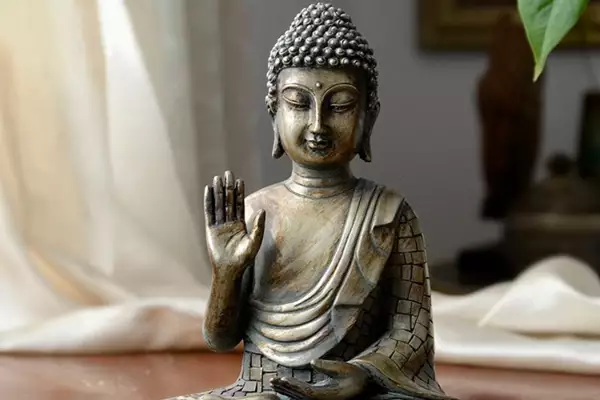In the Lok Sabha, the leader of the opposition (LoP) frequently displayed one of the Mudras in Buddhism called abhaya mudra, which stands for assurance and release from fear.

[Ref: Deccan Herald]
Table of Content
- Mudras in Buddhism
- Five Primary Mudras in Buddhism:
- Abhaya Mudra in Hindu Religion:
- Conclusion
- Frequently Asked Questions (FAQs)
Mudras in Buddhism:
- Mudras are intricate hand gestures serving as non-verbal communication in spiritual practices.
- They involve symbolic configurations of the hands and fingers to convey specific theological and metaphysical ideas.
- These gestures are not merely artistic expressions but are imbued with the capacity to invoke divine powers or depict deities, acting as a potent substitute for verbal articulation.
Significance:
- In the Buddhist context, each mudra is deeply interwoven with the teachings and episodes from Buddha’s life, providing a visual shorthand for complex philosophical narratives.
- This makes them invaluable tools for imparting spiritual wisdom and religious teachings, particularly within the educational frameworks of Buddhist traditions.
Five Primary Mudras in Buddhism:

[Ref: metmuseum]
The Abhaya Mudra:
- Recognized as one of the quintessential five primary mudras, this gesture is linked with Amoghasiddhi, the fifth Dhyani-Buddha.
- It is emblematic of protection, peace, and reassurance, typically represented with an open palm facing outward to signal benevolence and safety.
The Dharmachakra Mudra:
- This mudra, associated with Vairochana, the first Dhyani-Buddha, epitomizes the profound moment of Buddha’s first sermon.
- Here, the hands form a wheel-like gesture, symbolizing the Wheel of Dharma—a core principle in Buddhist teachings about the path to enlightenment.
The Bhumisparsha Mudra:
- It captures the pivotal moment of Buddha’s enlightenment under the Bodhi tree.
- This earth-touching gesture is linked with Akshobhya, the Dhyani-Buddha, and acts as a testament to the Earth witnessing Buddha’s transcendence to enlightenment.
The Varada Mudra:
- Often referred to as the “boon-granting” gesture, this mudra is associated with Ratnasambhava, the third Dhyani-Buddha.
- It is depicted with the palm facing downward, denoting generosity and fulfilment of all wishes.
The Dhyana Mudra:
- Symbolizing meditation, this posture is linked with Amitabha, the meditation Buddha.
- It represents deep concentration and the meditative state, essential for spiritual introspection and enlightenment.
Abhaya Mudra in Hindu Religion:
- The abhaya mudra transcends its Buddhist origins, integrating seamlessly into Hindu iconography.
- It features prominently in depictions of Hindu deities like Lord Shiva, Lord Vishnu, and Lord Ganesh, highlighting its significance and adaptability across various religious narratives.
- Beyond its aesthetic and religious significance, the abhaya mudra embodies a universal message of peace, protection, and reassurance.
- Its presence across different faiths underscores its role as a bridge between diverse spiritual traditions, offering a common language of compassion and security.
Conclusion
The abhaya mudra, a profound symbol of fearlessness and protection, transcends its origins in Buddhist traditions to hold significant meaning across multiple religions including Hinduism, Christianity, and Jainism. Its use by prominent figures in diverse religious contexts underscores its universal appeal as a symbol of peace, reassurance, and spiritual empowerment.
Ref: Source
| UPSC IAS Preparation Resources | |
| Current Affairs Analysis | Topperspedia |
| GS Shots | Simply Explained |
| Daily Flash Cards | Daily Quiz |
Frequently Asked Questions (FAQs)
What does the Abhaya Mudra represent in Buddhism?
The Abhaya Mudra in Buddhism symbolizes protection, peace, and reassurance. It is performed with an open palm facing outward, indicating safety and benevolence.
How does the Abhaya Mudra vary between Buddhism and Hinduism?
While the Abhaya Mudra represents peace and protection in both Buddhism and Hinduism, in Hindu iconography, it also features in depictions of deities like Lord Shiva and Lord Vishnu, signifying its broader spiritual significance across different faiths.
What is a Dhyani-Buddha?
A Dhyani-Buddha represents one of the five meditation Buddhas in Vajrayana Buddhism, each embodying a different aspect of the enlightened consciousness.
What is the Dharmachakra?
The Dharmachakra, or Wheel of Dharma, is a symbol representing the teachings of Buddha on the path to enlightenment. It is often depicted in art and religious iconography.


